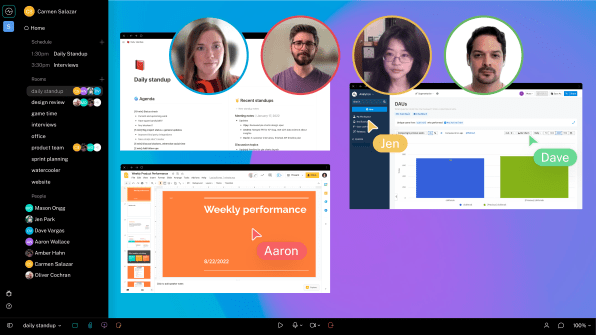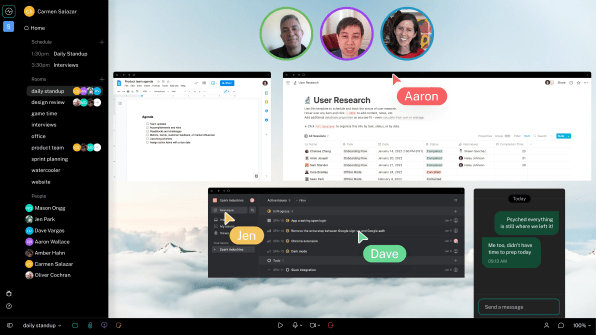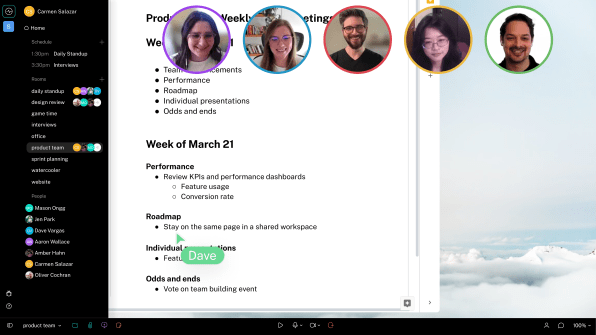Bye, Zoom: This smart new app is the future of online meetings
Accepted standards are funny things. You can use a tech tool for months or even years without ever thinking about its shortcomings—and then, the second you experience a better alternative, you wonder how you ever dealt with the now-clearly-flawed setup you’d stuck with for so long.
That’s exactly what happened to me with the current crop of mainstream videoconferencing systems—Zoom, Google Meet, or whichever flavor you happen to prefer. Like most people these days, I participate in more than my share of online meetings. And aside from the occasional internal grumbling, I usually don’t give much thought to the way they work or what could make them more effective.
But then I ran into a thoughtful new tool called Switchboard. It completely reimagines the way you interact and work with other people online. It takes the emphasis off faces and one-sided sharing and instead delivers a much-needed dose of real-world-like collaboration for your remote meeting experiences.
And no exaggeration: It’s so natural, sensible, and intuitive that once you’ve used it, you’ll never look at those other videoconferencing systems the same way again.
The Switchboard foundation
Switchboard’s story starts on a slightly quirky note.
When the pandemic hit, Amir Ashkenazi found himself frustrated with the state of his guitar lessons. He quickly discovered that while services like Zoom and Meet might be fine for basic conversation, they failed to deliver for his more interactive needs.
“What I realized is that those tools that we call collaboration platforms today are really just communication tools,” he says. “They allow us to see and hear each other and even allow us to show a screen, but when we actually want to do anything together, [they] really fall short.”
That realization inspired Ashkenazi to seek out a more harmonious solution. After two years of planning, building, and iterating, Switchboard was born. Ashkenazi is hardly a newbie at startups: He’s created and then sold three significant ones in the past (Shopping.com, which was acquired by eBay; Adap.tv, which was acquired by AOL; and Tookee, which was snatched up by LogMeIn before it even launched).
The easiest way to think of Switchboard is as an interactive canvas for your video calls. Instead of the default meeting visual being the faces of the participants, it’s a desktop—one that lives in the cloud, is specific to that individual meeting, and is available for all invited participants to share.
“In the real office, we focus on content,” Ashkenazi explains. “In video conferences, we focus on faces. It’s not natural—we’re not supposed to stare at our coworkers all day long.”
The centerpiece of the Switchboard setup is the humble internet browser—a familiar-feeling Chromium-based creation that exists entirely in that virtual environment and empowers you to create as many windows as you need. That means you can open and run practically any app that’s web-based, from Notion and Trello to Figma, Canva, and the entire suite of Google Workspace services. And then you can actually work in any of those apps anytime, collectively, without the need for any distracting view-switching or clunky manual sharing.

It’s a sharp and immediately noticeable contrast to the typical video conference. And that’s precisely what Ashkenazi set out to achieve—even more so with Switchboard’s advanced options.
Emulating the real world
Traditional videoconferencing is by its nature noninteractive. Sure, one person can share one thing at a time with everyone else. But, as Ashkenazi keenly observed, that’s not the way we actually work.
In Switchboard, he aimed to better emulate the real-world coworking experience while adding some useful extras into the equation. You can have multiple apps open simultaneously across any given room, for instance. You just sign in to any service the same way you would in any browser, and Switchboard then keeps you signed in just like your regular desktop browser does.
And, critically, anyone else you invite into the room can see and work on everything alongside you, as if they were right next to you and on the same computer.

Ashkenazi likes to call it the first operating system ever built for teams, and the analogy holds up surprisingly well. In addition to the endless array of browser windows, Switchboard lets you drag and drop files directly onto your shared canvas to have them appear in your room for everyone to see and interact with. It lets you add widget-like sticky notes into your work surface. You can paste the URL of a video from YouTube and have it show up as a floating video that can then play in sync for everyone present. And, yes, if you really want to share your screen in the traditional way, you can do that, too.
As for the faces, they’re there—just not as the primary point of emphasis. Instead, Switchboard shows all of a meeting’s participants inside small circles at the top of a room (though you can shift them around and change their size if you wish). Anyone can talk to the group and interact with any of a room’s elements. And if individuals want to present, a special command allows them to do so and have everyone else’s focus follow them around the canvas.

All basic structure aside, Switchboard presents one key advantage over our current videoconferencing standards—and over real-world meetings, too—and that’s its effortless permanence.
Plain and simple, any room you create remains in place and available for anyone you invite to reopen, revisit, and continue working in for as long as you like. Particularly for companies with recurring team meetings or ongoing group projects, that’s an immeasurable improvement over the awkward need to dig up all your notes, open every associated app, and start from square one each time you get going.
“Video calls start with zero and end with zero,” Ashkenazi says. “The real world—and Switchboard—is a world where permanence and memory exist.”
For now, Switchboard is free for anyone to use, and it’ll remain that way through the end of 2022. After that, Ashkenazi tells me it’ll likely move to a freemium-style model, which includes both a free offering for individuals and a more robust paid plan for organizations.
And if there’s one thing he can promise, it’s that what we’re seeing now is only just the beginning.
“You’re going to see more innovation in collaboration in the next three years than you’ve seen in the last probably 10 years,” he says.
Learn about all sorts of fascinating productivity boosters with my free Android Intelligence newsletter. Three things to know and three things to try every Friday.
(18)


